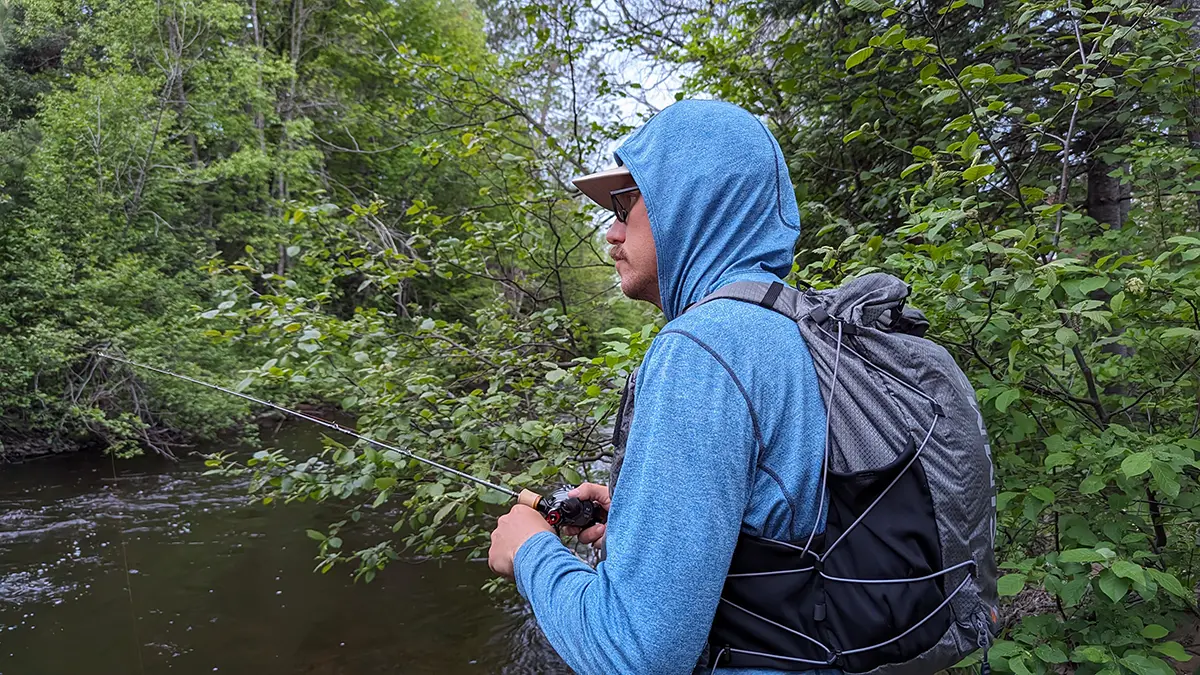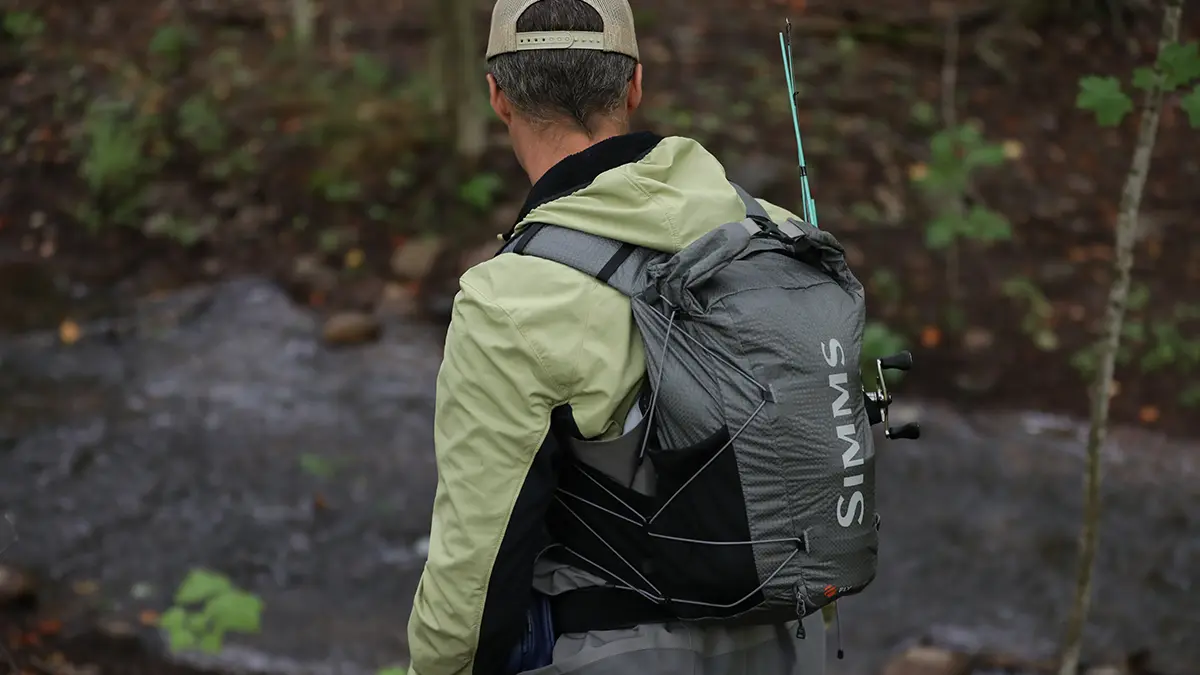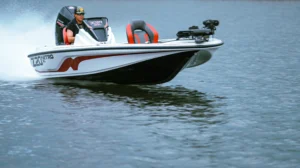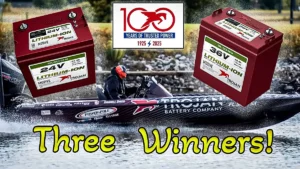Getting tackle prepped for a fishing trip is therapeutic for most anglers. I, however, dread the prep time required for making a fishing trip successful. Oftentimes, I will forget something and not realize until I need it. Having things pre-packed ahead of time in a fishing vest or backpack streamlines prep time and reduces the chances of forgetting key items. Luckily, Simms thought of forgetful anglers like me and released a combination fishing vest and backpack, the Flyweight Vest Pack that offers plenty of storage and organization.
I have tested the Simms Flyweight Vest Pack in a wide variety of conditions from snow to sweltering heat. Through unforgiving cedar swamps and dense alder thickets, my testing has quite literally brought me “over the river and through the woods” (although Grandmother’s house was not my destination). Enough of the cheesy jokes and time to dive into the features and my experience with the new Simms Flyweight Vest Pack.
INITIAL IMPRESSION
When I first received the Flyweight Vest Pack, I was impressed by the layout of the pockets and the weight of it. I was pleased that the new iteration had a more substantial build than the first generation.
The previous generation of the Flyweight Vest Pack looked more like a running vest, seemingly overemphasizing light weight over function. I immediately noticed when unboxing the new Flyweight Vest Pack that it was more robust; built more like a fishing vest than a running vest. Simms seemed to have used feedback by anglers regarding the previous generation Flyweight Vest Pack and applied lessons learned to create this version.
Weighing in at a mere 24 ounces, the Flyweight Vest Pack is lighter than most fishing vests on the market. With the 15 liter zip/buckle top backpack, the Flyweight Vest Pack is a day-tripper’s dream.
After getting the vest fitted and loaded with my initial kit, I rehearsed lure swaps, grabbing pliers and all that to ensure I was comfortable with how I had the Flyweight Vest Pack configured. Outside of a few odd looks from my neighbors, everything checked out and I was ready to take my testing to the stream for some real-world application.

HOW DOES IT PERFORM?
As a conventional trout angler, I found the fly fishing-designed pockets to adapt quite well for my modified kit. The lower pockets are quite roomy and fit a Plano 3449-22 double-sided tackle box perfectly. The chest pockets are surprisingly spacious and can keep a wide variety of items easily accessible.
The adjustable dual sternum straps and compression bungees on both sides provided a custom fit after some adjusting. I found taking the time to properly adjust the side compression bungees really helped distribute the weight of the vest to make the load feel lighter.
The S/M size fit my 6’0,” 180 pound body as well as a 5’5,” 140 pound female just fine. I would almost say the S/M size is “too large” based on how I have to adjust the sternum straps. Although not a design flaw, I thought I would be somewhere in the middle of the sizing instead of near the smaller end. I was able to wear the Flyweight Vest Pack over a thin sunshirt such as the Simms SolarFlex Hoody as well as bulky jackets with minimal adjustments.
The Flyweight Vest Pack has been comfortable to wear, even with a thin t-shirt. The mesh interior mitigates pressure points from seams as well as promoting airflow to regulate temperature. If using a hydration bladder, expect slight moisture from sweating/condensation during high output activities, as the bladder will reduce airflow when pressed against your back. I never found the hydration bladder-equipped Flyweight Vest Pack to hold in more moisture than a typical backpack would in similar conditions.

REAR AND POCKET STORAGE
The simple yet effective roll-top design of the Flyweight Vest Pack held all the gear I would reasonably expect to load it with. Jacket, food and other items fit well, and with the compression straps adjusted, the load felt much better than I expected. For those who like to tote camera gear, I did find carrying dense, oddly-shaped objects required careful balancing and cushioning in the backpack in order to be comfortable. Outside of that, I found the rear storage to carry everything I needed, even for unpredictable spring/fall weather.

If additional storage is needed, the Flyweight Vest Pack has a deployable “stuffit” pocket that can hold sweatshirts, rain jackets or other lightweight, bulky items to save space inside the main storage compartment. A common use for the stuffit pocket would be to hold a larger net. I attach my net via a magnetic holder affixed to a D-ring, so I generally keep the stuffit pocket stowed, keeping the pack streamlined for busting through brush. I did use the pocket to store my wet rain jacket after rain showers and to carry waders when I am hiking a few miles on dry land before reaching my destination.
The Flyweight Vest Pack has plenty of small, well-thought out storage options. Small mesh pockets on the outside of the chest pockets are designed to hold fly floatant and other small items. Loops can serve as attachment points for leader spools, forceps or anything else an angler may need for a day on the water.

With a 3 liter hydration bladder stashed inside, I found the back to bulge quite a bit. This is not a fault of the Flyweight Vest Pack, as Simms designed it to only carry a 2 liter bladder. Loading the hydration bladder about halfway (so it only contained 1.5 liters) felt great. The hydration bladder sleeve provided enough protection to ensure that the contents inside the rear storage compartment never got wet from condensation. I am also a weirdo and fill my hydration bladders with room temp water to reduce moisture.
Given the minimalistic nature of the Flyweight Vest Pack, odd heavy items such as a camera stored in the rear compartment need to be positioned carefully to avoid pressure on your back without a hydration bladder providing padding. I have thought about inserting a thin piece of pliable plastic into the hydration bladder sleeve to disperse the pressure but, I felt using the product as designed would give the reader the best understanding of how it performs. When hauling other items, I did not find any discomfort when using the Flyweight Vest Pack.

DURABILITY
The 150-denier nylon face fabric has held up quite well. The cedar swamps and alder brush I hike through to get into secluded streams seem to get enjoyment from tearing up gear. Other than minor pilling on the softer fabric, the Simms Flyweight Vest Pack has shown little signs of wear after many miles through a variety of abusive terrain.
Zippers on the pockets continuously operated as designed. I never encountered any malfunctions or jamming of the zippers. Even with heavy loads during testing, the seams have stayed tight and no separation of materials have been noticed.
LIMITATIONS
Although I found the 15 liter size to be adequate for most day trips, there are times I would have liked a bigger pack size. Simms does have a Flyweight Backpack that is 25 liters if you find yourself needing the extra storage space in lieu of the vest functions. Given that the Flyweight Vest Pack is designed as a daypack, I cannot really hold this against the product itself.
The side storage is the area I am most critical with the Flyweight Vest Pack. In order to provide breathability to the sides of the vest and allow for load balancing, the side pockets are placed slightly more rearward than most setups. This makes accessing a water bottle very difficult without taking the vest off. I found using the hydration bladder eliminated the need for quick access to water bottles but, when going out for a quick trip, I do not want to deal with the maintenance of draining and drying a hydration bladder. The side pockets do hold smaller items very well.

RANDOM THOUGHTS
Some seemingly random, but important thoughts I have on the Flyweight Vest Pack:
If you are into backpack camping, the Flyweight Vest Pack fits comfortably under hiking bags such as the Mystery Ranch Marshall. Be sure to keep the rear storage of the Flyweight Vest Pack empty when wearing the hiking pack. After setting up camp, you can take your essentials from your hiking pack and load the Flyweight Vest Pack for a day trip away from base camp.
A hydration bladder is not included. I prefer this because it allows the angler to repurpose ones they already own. It also reduces the cost of the Flyweight Vest Pack. For drinking, the hydration bladder tube can be rigged for the left or right shoulder.
The bottom sternum strap comes unfastened when I wear my Simms G4Z waders. This is due to the zipper; I went with a larger size with the Simms G4Z waders to accommodate layering in below freezing conditions. I don’t have this issue with the Simms G3 Guide waders or wearing without waders.
If using a chest camera to film your adventures, you can adjust the sternum straps up and down to fit around your camera.
VERDICT: RECOMMEND
During my field testing, I thought the retail price of the Flyweight Vest Pack would have been around $250-270. I was pleasantly surprised it came in at $199.95. In motorsports, they say you can only pick two—fast, inexpensive or reliable. Unfortunately, that same saying can be applied for many fishing products today. For a premium price, you are getting a fully-functional fishing vest and a hydration bladder-compatible backpack all in a lightweight package.

I have historically never been a vest angler, relying on my wader pockets to carry whatever tackle I need. The Flyweight Vest Pack changed that. Having everything I need for fishing as well as snacks and a jacket gives me less of a chance to forget key items for fishing. Now I just need to make sure I do not forget the Flyweight Vest Pack before I hit the water.













